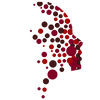The key to success here is recognizing all the coughing behavior you actually do. Many patients are unaware of exactly how much coughing and throat clearing they do, especially when they have been coughing so much, for so long. The SLP staff will assist in helping you to identify these behaviors. Learning to pay attention in this regard will be critical to your overall success in overcoming the cough. See a Cough Cessation Protocol handout here.
Swallowing to prevent a coughing event
Coughing is a traumatic event where the vocal cords clap together forcefully. Think about clapping you hands together, frequently, all day long. Your palms would be sore and irritated. Now imagine how your vocal cords must “feel” after a day of coughing!
When we swallow, the vocal cords come together, as they do during a cough, but in a much more gentle manner. In this sense, swallowing can act similar to “rubbing an itch” instead of harshly scratching an itch. In many cases then, swallowing can help to lessen the itch or tickle, enough to where you feel you can manage without coughing or throat clearing. This saves your vocal cords the trauma of the cough. The more often you are able to do this, and avoid a cough, the more your vocal cords are able to recovery, becoming less and less sensitive.
The first two weeks are particularly difficult, but the more success you have in reducing your coughing behavior, you will notice you no longer feel the urge to cough as often. As this continues, the cough cycle reverses and in a few weeks you are coughing significantly less. Success!
Here are the general guidelines in reducing your coughing behavior:
- DON’T SMOKE!!! And avoid smoky environments.
- Sleep with a humidifier.
- STOP THROAT CLEARING!
o This is non-reflexive behavior that you have control over.
o Recognize when you are doing this.
o Swallow or take sips of water instead of throat clearing.
o BE VERY DISCIPLINED.
- When you feel a “tickle” or a coughing coming:
o TRY VERY HARD TO KEEP FROM COUGHING.
o Swallow HARD.
o “Hold” your swallow.
o Drink, drink, drink water!
Of course, there will be times when you simple can’t keep from coughing. In those cases, always try to cough as little as possible, trying to gain control over the cough instead of the cough taking control of you.
When you can’t seem to stop coughing:
- Try VERY HARD to take a long, deep breath through your nose (trying to keep the inhale going, even if very slow and shaky).
- Try to swallow HARD.
- Try drinking water.
- "Hold" your swallow.

